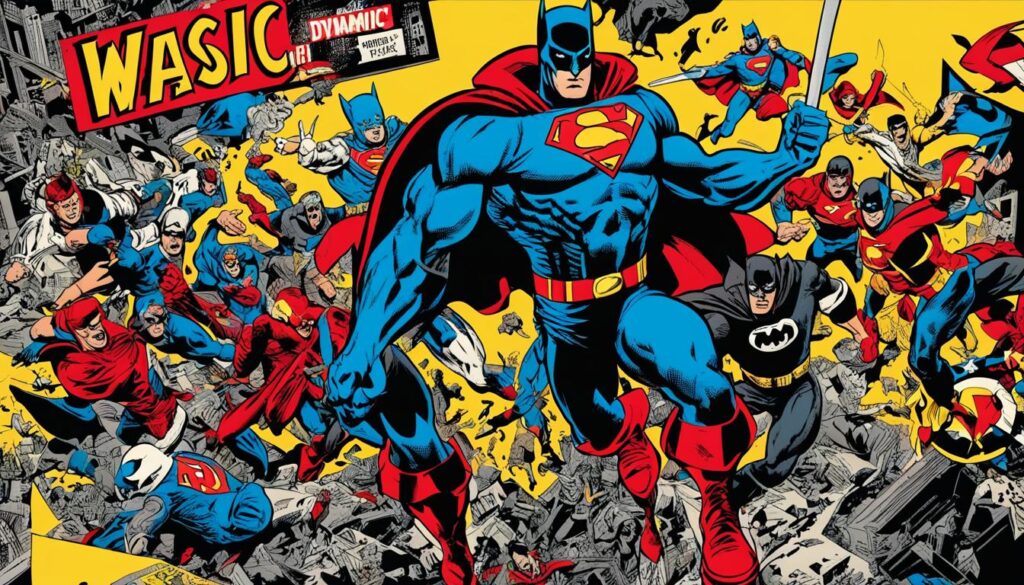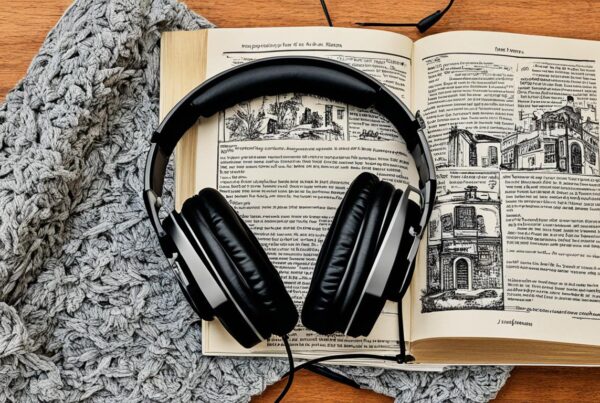In this audiobook review, we explore “The Ten-Cent Plague” by David Hajdu and how it examines the impact of comic books on American culture. This book delves into the comic-book scare of the 1950s, which resulted in parents, educators, and lawmakers expressing concerns about the influence of comic books on children. “The Ten-Cent Plague” highlights how comic books transformed American culture, including the social and political implications, making it a captivating and informative read.
Key Takeaways
- “The Ten-Cent Plague” by David Hajdu explores the impact of comic books on American culture.
- This book discusses the comic-book scare of the 1950s and its implications on American society.
- “The Ten-Cent Plague” provides unique insights into the subject matter through David Hajdu’s research methods and interviews.
- The narration and production of the audiobook version of “The Ten-Cent Plague” are of high quality.
- This book has made significant contributions to comic book scholarship and has garnered critical acclaim.
Overview of “The Ten-Cent Plague”
“The Ten-Cent Plague” by David Hajdu is a book that focuses on the comic-book scare of the 1950s, examining how comic books transformed American culture. The book analyzes the concerns raised by parents, educators, and lawmakers about the influence of comic books on children and traces the rise and fall of the comic-book industry. Through interviews with key figures and extensive research, Hajdu provides a compelling narrative that sheds light on this important period in American history.
The book’s main themes include the role of comic books in society, censorship, and freedom of speech. Its context is the postwar era in America, a time of cultural upheaval and rapid change. The significance of “The Ten-Cent Plague” lies in its contribution to our understanding of the comic-book scare and its impact on American culture.
The book is widely considered to be a landmark work in the field of comic book scholarship and is a must-read for anyone interested in the medium’s history and cultural significance.
The History of Comic Books in America
Comic books have a long and fascinating history in America, dating back to the late 19th century with the introduction of “The Yellow Kid” in 1895. Initially, comic books were primarily aimed at children and featured characters like Mickey Mouse and Superman. However, they quickly gained popularity with adults as well, paving the way for the emergence of different genres such as horror, romance, and crime.
The Golden Age of comic books, which lasted from the late 1930s to the mid-1950s, saw a significant upsurge in the popularity of comic books. This was attributed to the rise of superheroes such as Superman, Batman, and Captain America. The creation of these iconic characters helped to establish comic books as a cultural phenomenon in America.
During the 1950s, there was growing concern about the influence of comic books on children. This resulted in the comic-book scare, which led to the creation of the Comics Code Authority (CCA) in 1954. The CCA imposed strict guidelines on the content of comic books, effectively ending the Golden Age and ushering in the Silver Age.
In the ’60s and ’70s, comic books underwent a significant transformation, with the emergence of counterculture and underground comics. These comics challenged traditional notions of morality and explored complex social issues such as race and gender. This era saw the rise of publications like “Zap Comix” and “Heavy Metal Magazine,” which helped to shape the direction of the comic book industry for years to come.
The history of comic books in America is a rich and complex one, with a lasting impact on American culture as a whole. From the Golden Age of Superman to the counterculture of the ’60s and ’70s, comic books have continually evolved to reflect the social and political currents of the times.
The Comic-Book Scare
The 1950s witnessed a nationwide fear among parents, educators, and lawmakers about the potential negative influence of comic books on children. The concern was driven by a growing unease that comic book publishers were targeting children with graphic and violent content, leading to a moral decline in society.
Popular media outlets fueled this phenomenon with sensational headlines that warned of the dangers of comic books. Parents and teachers were urged to prohibit children from reading comic books, and lawmakers were motivated to take action. The 1954 U.S. Senate Subcommittee Hearings on Juvenile Delinquency sought to investigate the impact of comic books on children and culminated in the creation of the Comics Code Authority, which regulated the content of comic books.
The comic-book scare had a lasting impact on American culture, and it informed the public perception of comic books for decades to come. David Hajdu’s “The Ten-Cent Plague” examines this fascinating moment in cultural history and offers insights into the role of comic books in American society and the impact of the comic-book scare.
The Role of “The Ten-Cent Plague” in American Culture
David Hajdu’s “The Ten-Cent Plague” is an insightful analysis of how comic books transformed American culture. Through the lens of cultural, social, and political implications, this book brilliantly illustrates how comic books, once disregarded as low-brow entertainment, emerged as a powerful medium for the expression of American identity.
Hajdu’s meticulous research and analysis serve to illuminate the ways in which comic books challenged widespread conventions and ushered in a new era of artistic creativity. He argues that the cultural and social phenomenon that was comic books in the mid-twentieth century paved the way for the graphic novels and superhero franchises that continue to shape American popular culture today.

The lasting impact of “The Ten-Cent Plague” cannot be overstated. Through its examination of the comic-book scare and the wider context in which it took place, this book offers an unparalleled perspective on the transformative power of comic books in American society. It is a must-read for anyone interested in American culture, popular media, and the way in which art and entertainment can have profound consequences for society at large.
Author David Hajdu’s Perspective
In “The Ten-Cent Plague,” David Hajdu draws on his extensive research, interviews, and unique perspective to provide a compelling analysis of the comic-book scare and its impact on American culture. Hajdu’s approach is interdisciplinary, using historical, sociological, and cultural lenses to examine the issue from multiple angles.
As an expert on popular culture, Hajdu’s writing is engaging and accessible, making complex ideas and theories easy to understand for readers of all backgrounds. He sets the scene and creates vivid descriptions, immersing readers in the world of comic books and the context in which they emerged.
In interviews, Hajdu has explained that his interest in comic books and their history was sparked by his personal affinity for the medium, as well as his scholarly curiosity. He is passionate about the role of comics in American culture and believes that they are essential to understanding the evolution of popular media in the country.
Hajdu’s perspective on the comic-book scare is nuanced and insightful, providing a balanced assessment of the issue and its repercussions. He does not shy away from addressing the legitimate concerns raised by critics, but also acknowledges the role that fear and hysteria played in the backlash against comic books.
Narration and Production of the Audiobook
Bringing “The Ten-Cent Plague” to life in audiobook format requires skilled narration and expert production. The audiobook version of the book, produced by Blackstone Audio, is narrated by Stefan Rudnicki, and runs for 12 hours and 18 minutes, making it accessible to listeners on the go.
Rudnicki’s narration captures the essence of the book’s style and tone, maintaining a consistent pace and delivering a clear, crisp performance. His engaging narration style enables listeners to stay focused on the content, while also enjoying the listening experience.
The overall production quality of the audiobook is exceptional, with clear and seamless audio and intuitive chapter navigation. The production team has successfully transformed the book into an engaging and captivating audiobook experience.
Impact of “The Ten-Cent Plague” on Comic Book Scholarship
David Hajdu’s “The Ten-Cent Plague” has had a significant impact on the field of comic book scholarship. The book’s comprehensive examination of the comic-book scare’s effects on American culture and society has provided new insights and perspectives for scholars to explore. It has become a valuable resource for researchers and academics, and many have cited “The Ten-Cent Plague” in their own work.
The book’s influence extends beyond academia, as it has also played a role in shaping public discourse around comic books and their cultural significance. “The Ten-Cent Plague” helped to spark a renewed interest in comic-book history and scholarship, leading to new opportunities for research and analysis.
The impact of “The Ten-Cent Plague” can be seen in the numerous scholarly articles and books that have been published in its wake. It has influenced research on a wide range of topics related to comic books, including their historical context, artistic styles and techniques, and social and political implications. Through its rigorous research and engaging writing, “The Ten-Cent Plague” has become a touchstone for comic book scholarship.
Reception and Critical Acclaim
Since its publication, “The Ten-Cent Plague” has received widespread critical acclaim and positive reception from readers and experts alike.
The book was praised for its well-researched and engaging account of the comic-book scare and its impact on American culture. Many reviewers applauded David Hajdu’s journalistic style, vivid storytelling, and careful attention to detail in exploring the historical context and cultural significance of comic books.
According to The New York Times, “The Ten-Cent Plague” is a “remarkable book” that “tells a fascinating story of fear, censorship, and art that is sure to provoke serious debate.” The Washington Post called it a “powerful and necessary chronicle” that “sheds light on a little-known but significant episode in the history of American popular culture.”
The book also received the prestigious Eisner Award for Best Comics-Related Book in 2009, further cementing its impact and influence on the field of comic book scholarship.
Notable Reviews
| Publication | Review |
|---|---|
| The New York Times | “A remarkable book…sure to provoke serious debate.” |
| The Washington Post | “A powerful and necessary chronicle…sheds light on a little-known but significant episode in the history of American popular culture.” |
| Los Angeles Times | “An impressively researched and thoroughly gripping cultural history…[Hajdu] brilliantly illuminates how the battle over comic books might have anticipated much of the cultural conflict to come.” |
Overall, “The Ten-Cent Plague” has established itself as a seminal work in American cultural history and is widely regarded as essential reading for anyone interested in the history of comic books, censorship, and free expression.
Conclusion
In conclusion, “The Ten-Cent Plague” by David Hajdu provides a comprehensive analysis of the comic-book scare in America and its impact on American culture. Through his meticulous research and interviews, Hajdu sheds new light on the history of comic books and their influence on society. The audiobook version of “The Ten-Cent Plague” is expertly narrated and produced, making it an enjoyable and informative listening experience.
David Hajdu’s unique perspective and insights into the subject matter contribute significantly to our understanding of the comic-book industry and its cultural implications. His work has also made an important contribution to comic book scholarship, influencing future research and discussions in the field.
Overall, “The Ten-Cent Plague” is a must-read for anyone interested in the history of comics and their impact on American culture. It provides an illuminating and thought-provoking analysis of how comic books transformed American society and the subsequent reactions of those who feared their influence.
FAQ
What is "The Ten-Cent Plague"?
“The Ten-Cent Plague” is a book by David Hajdu that explores the impact of comic books on American culture during the comic-book scare of the 1950s.
What is the main focus of "The Ten-Cent Plague"?
The main focus of “The Ten-Cent Plague” is to examine how comic books influenced American culture and the concerns raised by parents, educators, and lawmakers about their impact on children.
How does "The Ten-Cent Plague" contribute to understanding comic-book history?
“The Ten-Cent Plague” provides insights into the history of comic books in America, discussing their rise in popularity, the emergence of different genres, and their cultural significance.
What is David Hajdu’s perspective in "The Ten-Cent Plague"?
As the author of “The Ten-Cent Plague,” David Hajdu offers unique perspectives based on his extensive research, interviews, and knowledge of the subject matter.
How is the audiobook version of "The Ten-Cent Plague" narrated and produced?
The narration and production of the audiobook version of “The Ten-Cent Plague” are evaluated in terms of performance and overall quality.
What impact has "The Ten-Cent Plague" had on comic book scholarship?
“The Ten-Cent Plague” has made significant contributions to comic book scholarship, influencing future research and expanding the understanding of comic books’ cultural and historical significance.
How has "The Ten-Cent Plague" been received by readers and experts?
The reception and critical acclaim of “The Ten-Cent Plague” are explored, including notable reviews and reactions from readers and experts in the field.
What are the key takeaways from this audiobook review of "The Ten-Cent Plague"?
This audiobook review summarizes the main points discussed, highlighting the significance of “The Ten-Cent Plague” in shaping American culture through the lens of comic books.



